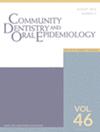A Three Delays theoretical framework to describe social determinants as barriers to dental care
Abstract
Objectives
The Three Delays model is a well-established global public health framework for the utilization of obstetric services where each delay represents a series of factors affecting utilization: (1) Delay #1—Deciding to seek care, (2) Delay #2—Reaching an appropriate facility and (3) Delay #3—Receiving adequate care. The aim of this qualitative study was to explore the application of the Three Delays model to dental service utilization and describe factors attributed to delayed utilization within this framework.
Methods
This study utilized a framework analysis, underpinned by the Three Delays model, to examine delays in dental care utilization. A criterion purposive sample of English-speaking adults (18+ years) in Massachusetts and Florida, USA with limited dental care access was recruited. Data were collected via semi-structured interviews conducted in two phases: 17 individual interviews, followed by interviews with a subset of five participants over 3 months (a total of 18 interviews). The analysis involved inductive thematic coding and systematic organization within the framework.
Results
Major themes and subthemes were constructed from the participants' narratives, identified and categorized as factors in the Three Delays framework. Each of the delays was interrelated to the other two, and Delay #1 was the most common delay based on the participants' interviews. The themes and subthemes contributing to one or more delays included interpersonal communication, prior dental experience, financial considerations, childcare costs, social connection, technology literacy, time constraints, competing priorities, stressors such as eviction and immigration status and microaggressions including racism and stigma.
Conclusion
The Three Delays model was applicable to the study of dental care utilization and factors that impact the decision to seek dental care, reaching an appropriate dental facility and receiving adequate dental care in this study context.

 求助内容:
求助内容: 应助结果提醒方式:
应助结果提醒方式:


